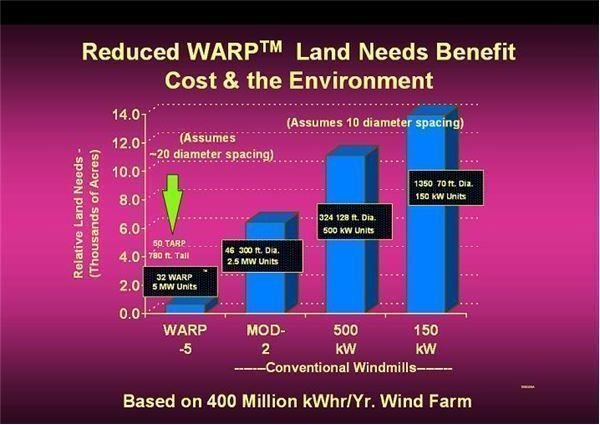WARP vs Turbine: Comparison of Wind Power Plants – Part I
Introduction
Just in case you missed it, we had studied about Wind Amplified Rotor Turbine or WARP in a previous article and there have been several articles on wind turbines and wind power plants as well (see suggested readings below). In this article I want to bring out some of the more prominent features of a WARP arrangement and why is it more suitable than a wind turbine.
Reasons for Preference
If one product or machinery is preferred over the other, then there must be a set of substantial reasons for that preference. There exist several reasons for this and that is why these have been explained in a series of articles rather than a single article, so that each point could be dealt with in detail. So here is the list of reasons and the relative comparison.
Land/Space Requirements
The surface area of the earth is limited which means that land is a precious resource. Windmills and wind power plants (except for very small projects) are normally spread over several acres in the form of wind farms. Hence the amount of space that a typical wind farm occupies is surely an important factor. In this factor the WARP surely is much ahead of the race as compared to conventional wind turbines. Since a picture (as well as a graph) is worth a thousand words, just take a look at the graph shown in figure 1 which shows the relative comparison between WARP units and conventional wind turbine units of various capacities.
You can see from the chart that a typical WARP power farm which consists of 32 units of 5 MW each (160 MW total) occupies less than one thousand acres of land but 324 units of 500 KW (162 MW total) wind turbine farm needs an exorbitant 11000 acres of land. You might say that it is because the power units are not of the same capacity so just take a look at the same graph and you can see that even if the wind turbines are of 2.5 MW capacity each, still it requires nearly 7000 acres of land. You can also consider the fact that 20 meters of spacing is assumed between WARP units while only 10 meter spacing is assumed between wind turbines, hence the effect of lower power units in the latter is offset to some extent in this comparison.
It goes without saying that this is certainly a big advantage since the area of land required is reduced to such an extent. Normally companies take land on lease for long periods of time and just imagine the savings in costs which could be done when a same capacity wind farm can be built in much lesser land which would reduce electricity costs that can be passed on to the customers. But this is not the only advantage and we will continue to take a look at some other advantages in the next article on this series.
Figure 1: WARP vs Wind Turbines
References
Figure 1: WARP vs Wind Turbines (Courtesy: Eneco Corporation, Texas)
Suggested Readings
WARP vs Turbine: Comparison of Wind Power Plants – Part IV
WARP vs Turbine: Comparison of Wind Power Plants – Part III
